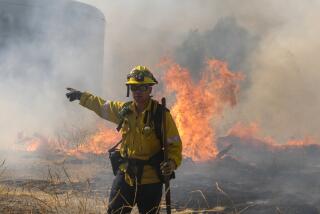Film insurer’s goal is to keep cameras rolling
Filming on the next installment of “The Hunger Games” won’t begin for another month, but Paul Holehouse already is assessing the risks.
Holehouse will fly to Atlanta this week to check for asbestos in an old warehouse — one among many sites that will be used during filming of the “Hunger Games” sequels.
He’ll also meet with stunt coordinators to review action scenes, plans for pyrotechnics and training for actors to ensure they are prepared to film various fights and chase scenes.
PHOTOS: Fireman’s Fund Insurance Co.
He’s not directing or producing the movies. An entertainment risk consultant for Fireman’s Fund Insurance Co., which insured “The Hunger Games” and is covering the next two films, he’s watching out for the accident or unforeseen delay that can shut down production and cost a big-budget movie $300,000 to $500,000 a day.
“We don’t want to have any down times or delays, because that’s what kills you in this business,” Holehouse said.
Few companies know that better than Fireman’s Fund Insurance, which has been taking a gamble on Hollywood since “The Valley of the Giants” and other movies from the silent film era.
The California company, owned by German insurance giant Allianz Group, is celebrating its 150th anniversary, including a century in the film industry, where it is the largest provider of insurance. Based in Novato, Fireman’s Fund employs 60 people in its entertainment division, which has its headquarters in Burbank.
In recent years, Fireman’s Fund also has expanded into new areas and opened new offices in Toronto and Britain as production has become increasingly global. In addition to movies, Fireman’s Fund also underwrites about 60% of reality TV shows as well as live concerts, music festivals and special events such as the Super Bowl halftime show and the Grammy Awards.
PHOTOS: Hollywood Backlot moments
On Tuesday, the company will host an event at the former Grauman’s Chinese Theatre in Hollywood to mark its anniversary. On display will be artifacts and memorabilia from some of the classic movies it has insured over the decades, including “Spartacus,” “The Godfather,” “Apocalypse Now” and more recent blockbusters such as “The Dark Knight Rises.”
Fireman’s Fund covers about 80% to 85% of the $200 million or more in policies Hollywood spends each year to insure movies and TV shows. Premiums range from 1% to 4% of a movie’s budget, meaning that a $200-million movie may spend at least $2 million on insurance coverage.
The lucrative premiums have drawn more players into the business. Fireman’s Fund’s growing rivals include Chubb Group, Travelers, ProSight Specialty, Hiscox and HCC.
But Lauren Bailey, vice president of the entertainment division for Fireman’s Fund, isn’t worried about the competition.
“People are somewhat attracted to higher premiums,” Bailey said. “At the end of the day, what we have seen historically is that a lot of the carriers don’t have staying power. They are attracted to the big premiums, but will they stay after a big loss?”
As a hedge against losses, filmmakers buy a broad package of insurance that includes coverage for equipment and vehicles, props and sets as well as the costs of reshoots because of bad weather, defective film stock or even damage caused by computer viruses. Then there is so-called cast coverage, which compensates producers for losses they incur because of an injury, illness or death of an actor.
ON LOCATION: Where the cameras roll
Fireman’s Fund says it has insured more than 1,400 films in the last decade alone. Although the company would not disclose actual figures, executives said its entertainment premium grosses have increased an average of 15% annually over the last five years, reflecting the rising budgets of major studios’ movies, said Wendy Diaz, senior underwriting director for Fireman’s Fund.
The average claim Fireman’s Fund paid to a film or TV producer in 2012 was $60,651, up 20% from $50,390 in 2009, the company said.
Some claims, however, are substantially more, underscoring the risks of insuring movies and TV shows.
When Audrey Hepburn fell from a horse while making “The Unforgiven,” her resulting back injury delayed filming of the 1960 John Houston movie. Fireman’s Fund paid more than $240,000 to cover the losses.
“Spartacus” was more costly for the insurer, which paid $245,000 for delays caused by an emergency operation for actress Jean Simmons, $53,000 for star Kirk Douglas’ viral infection and $335,000 for co-star Tony Curtis’ severed Achilles tendon.
But its most expensive claim was for “Wagons East.” Fireman’s Fund paid about $15 million when star John Candy died in 1994 during production in Durango, Mexico.
The insurer paid a $7-million claim after Patrick Swayze fell off a horse and broke his legs during filming of the 1998 crime movie “Letters From a Killer,” Diaz said.
PHOTOS: Fireman’s Fund Insurance Co.
To minimize such losses, Fireman’s Fund relies on experts such as Holehouse to evaluate risks and advise filmmakers on how to prevent accidents that can cause costly delays.
In addition to evaluating general hazards, such as bear attacks or potential waterfall slippages (among the potential risks in the first “Hunger Games” movie), Holehouse works closely with stunt departments to protect stars such as Angelina Jolie from on-the-job dangers.
In the movie “Salt,” which won Fireman’s Fund’s 2010 award for riskiest movie, Jolie’s character jumped from a freeway overpass onto a moving truck and performed hand-to-hand combat. Holehouse made sure that some of the more dangerous scenes were handled by a stunt double.
Likewise, he limited the motorcycle chase scenes that actress Rooney Mara performed in the 2011 thriller “The Girl With the Dragon Tattoo.”
“It wasn’t that hard a call,” Holehouse said. “If she went down, the whole movie would go down.”
More to Read
From the Oscars to the Emmys.
Get the Envelope newsletter for exclusive awards season coverage, behind-the-scenes stories from the Envelope podcast and columnist Glenn Whipp’s must-read analysis.
You may occasionally receive promotional content from the Los Angeles Times.









